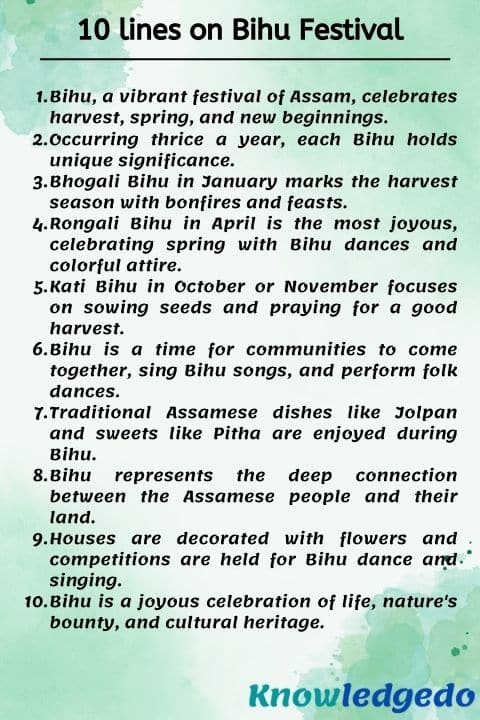Today, we are sharing 10 lines on Bihu Festival in English. This article can help students who are looking for information about 10 lines on Bihu Festival. These lines are straightforward and easy to remember. The level of difficulty is moderate, making it accessible for any student to write on this topic.
This article is generally useful for class 1,class 2,class 3,class 4,class 5,class 6,class 7,class 8,class 9,class 10,class 11,class 12
10 lines on Bihu Festival
1) Bihu, a vibrant festival of Assam, celebrates harvest, spring, and new beginnings.
2) Occurring thrice a year, each Bihu holds unique significance.
3) Bhogali Bihu in January marks the harvest season with bonfires and feasts.
4) Rongali Bihu in April is the most joyous, celebrating spring with Bihu dances and colourful attire.
5) Kati Bihu in October or November focuses on sowing seeds and praying for a good harvest.
6) Bihu is a time for communities to come together, sing Bihu songs, and perform folk dances.
7) Traditional Assamese dishes like Jolpan and sweets like Pitha are enjoyed during Bihu.
8) Bihu represents the deep connection between the Assamese people and their land.
9) Houses are decorated with flowers and competitions are held for Bihu dance and singing.
10) Bihu is a joyous celebration of life, nature’s bounty, and cultural heritage.

20 lines on Bihu Festival
1) Bihu, Assam’s vibrant festival, celebrates harvests, the changing seasons, and fresh starts.
2) Celebrated thrice annually, each Bihu holds a distinct character.
3) Bhogali Bihu in January kicks things off with bonfires, feasts, and thanksgiving for the harvest.
4) Rongali Bihu in April is the crown jewel, bursting with Bihu dances in colourful attire to welcome spring.
5) During Rongali Bihu, houses are adorned with flowers, creating a festive atmosphere.
6) Vibrant Bihu songs fill the air, sung by communities coming together in joyous celebration.
7) Traditional delicacies like Jolpan (multi-course meals) and Pitha (sweets) tantalize taste buds.
8) Folk dances like Bihu Naach and Husori enthral audiences with their energetic steps.
9) Kati Bihu in October/November focuses on sowing seeds, with prayers for a bountiful harvest.
10) Bihu is a time for families to reunite, strengthening bonds and sharing stories.
11) Young people look forward to Bihu for the Bihu Geets (songs) filled with romance and merriment.
12) Traditional games like buffalo fights (non-violent) and tug-of-war add a playful element.
13) Bihu showcases Assam’s rich textile heritage with vibrant Mekhela Chadors worn by women.
14) Competitions in Bihu dance and singing add a competitive spirit to the festivities.
15) Bihu reflects the deep connection between the Assamese people and their agricultural roots.
16) The spirit of Bihu transcends religion, uniting communities in shared joy.
17) Bihu is a photographer’s paradise, capturing the colourful attire, lively dances, and joyful faces.
18) The energetic rhythm of Bihu music is infectious, leaving everyone wanting to join the celebration.
19) Bihu is a reminder to appreciate nature’s bounty and the simple joys of life.
20) Witnessing Bihu is an unforgettable experience, leaving a lasting impression on visitors.
5 Lines On Bihu Festival
1) Assam’s vibrant Bihu celebrates harvests, spring’s arrival, and fresh beginnings throughout the year.
2) Three unique Bihu festivals mark the cycle: Bhogali (harvest), Rongali (spring), and Kati Bihu (sowing).
3) Joyful Bihu dances, colourful attire, and traditional songs fill the air during celebrations.
4) Communities gather for feasts, games, and thanksgiving, reflecting their bond with nature.
5) Bihu is a joyous expression of Assamese culture and heritage.
FAQ
Answer: Bihu is a vibrant festival celebrated thrice a year in the Indian state of Assam. It’s a celebration of harvest, seasons, and new beginnings.
Answer:
Bhogali Bihu (January): Marks the harvest season with bonfires, feasts, and thanksgiving.
Rongali Bihu (April): The most joyous Bihu, celebrating spring with Bihu dances and colourful attire.
Kati Bihu (October/November): Focuses on sowing seeds and praying for a good harvest.
Answer:
Bihu Dances: Energetic folk dances like Bihu Naach and Husori.
Traditional Food: Delicacies like Jolpan (multi-course meals) and Pitha (sweets).
Colourful Attire: Vibrant clothing, particularly Mekhela Chadors worn by women.
Community Gatherings: Singing Bihu Geets (songs), games, and strengthening family bonds.
Answer: Bihu reflects the deep connection between the Assamese people and their land. It transcends religion, uniting communities and celebrating life, nature’s bounty, and cultural heritage.
